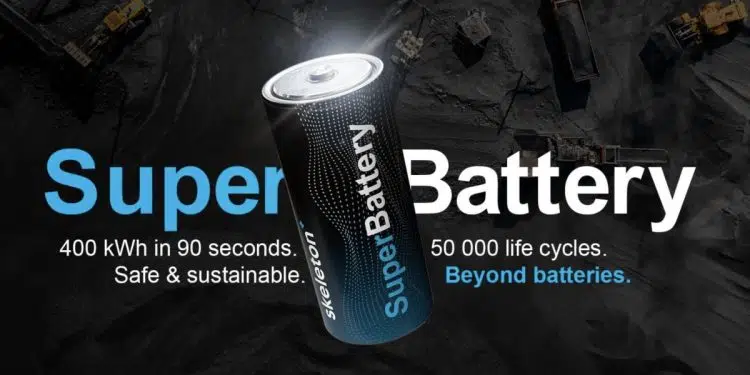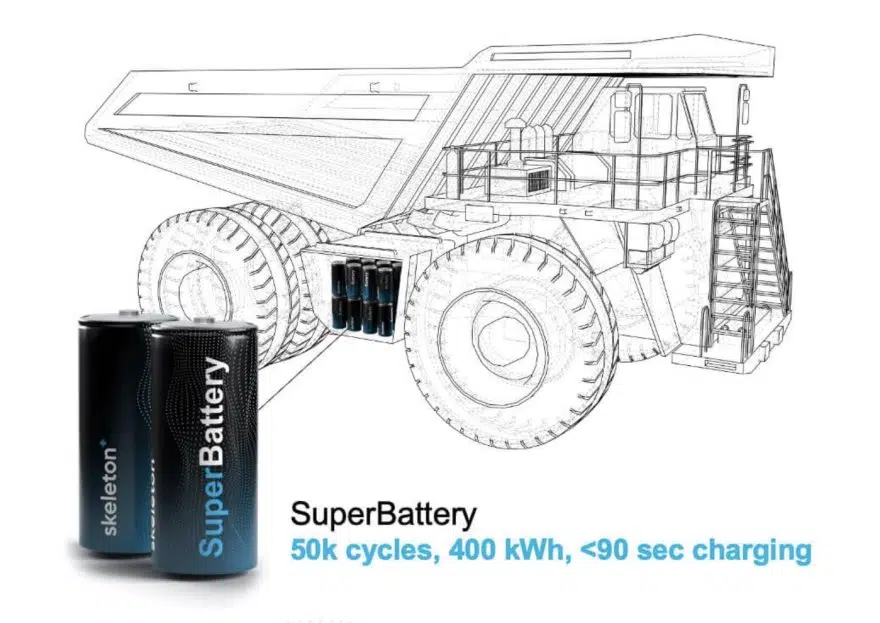Skeleton Technologies, the global technology leader in fast charging for transportation, grid, automotive, and industrial applications, is delighted to officially launch its SuperBattery, and to unveil Shell as partner. Skeleton is joining a Shell-led consortium to offer electrification solutions for mining sites.
SuperBattery is an innovative technology combining the characteristics of supercapacitors and batteries. SuperBattery has been developed to serve the needs of several sectors and is currently being used and/or tested in hybrid and fuel cell EVs, buses, trucks, and charging infrastructure.
Taavi Madiberk, CEO and co-founder of Skeleton Technologies, says:“Skeleton goes after the high-power part of the energy storage market and we estimate the addressable market size to be 95 Bn EUR. Now, the key is to move ahead with the scale-up and we aim to develop our business around SuperBattery through key partners such as Shell.”
Decarbonization in mining largely relies upon electrification and renewables, which are the best way to reduce operational emissions. Electrification of heavy-duty applications is both a necessity and a major challenge for the mining industry.
Grischa Sauerberg, Vice President, Sectoral Decarbonisation and Innovation at Shell explains: “The challenge of decarbonisation is immense, but not impossible – providing collaboration and innovation go hand in hand at all times. We are proud to work alongside Skeleton – and our consortium members – to develop a new pilot offering of electrification solutions for off-road vehicles and to demonstrate how partnership and close collaboration can help mining businesses meet their environmental goals. Skeleton’s technology, providing ultrafast charging at ~< 90 seconds, means the solution can help mining companies reduce emissions without compromising on efficiency.”
The nine-member consortium, including Skeleton and Shell, has come together to introduce Shell’s Mining Electrification Solutions for Off-Road Vehicles – announced in May 2022 as one of the 8 winners of the mining industry’s ‘Charge On Innovation Challenge’, from over 350 entries. The solution is an end-to-end and interoperable electrification system that reduces emissions without compromising on efficiency or safety, whilst aiming to be cost competitive versus diesel-powered operations. The pilot offering combines ultra-fast charging with Skeleton’s new SuperBattery, in-vehicle energy storage, and power provisioning and microgrids.
Taavi Madiberk continues: “Over the next 7 years, the mining sector represents a multi-billion revenue opportunity for Skeleton. This is not only driven by decarbonization, but by tangible economic benefits for our customers. Skeleton is focused on reducing emissions in hard-to-decarbonize sectors. But we cannot achieve it alone, we can only do it with partners. Close collaboration with Shell is key for us, with potential going way beyond mining applications.”
SuperBattery combines several advantages which make it a perfect fit for Shell’s Mining Electrification Solutions for Off-Road Vehicles. Skeleton’s patented Curved Graphene material allows for 100 x faster charging compared to standard Lithium-ion batteries. Used in off-road vehicles, SuperBattery can be charged in less than a minute, therefore requiring much less charging time spent per day: less than an hour, whereas 6.5 hours are needed with a lithium-ion battery. More time can therefore be spent on mining, and less on charging. SuperBattery has 50,000 life cycles, and is free from cobalt, copper, nickel, and graphite. It is also much safer than a lithium-ion battery, even when crushed, overheated, or pierced.
SuperBattery fills the technology gap in the energy storage market, delivering peak power and fast charging, and is best suited for applications below 30 minutes because of lower cost and footprint. The start of mass production is planned for 2024.
































